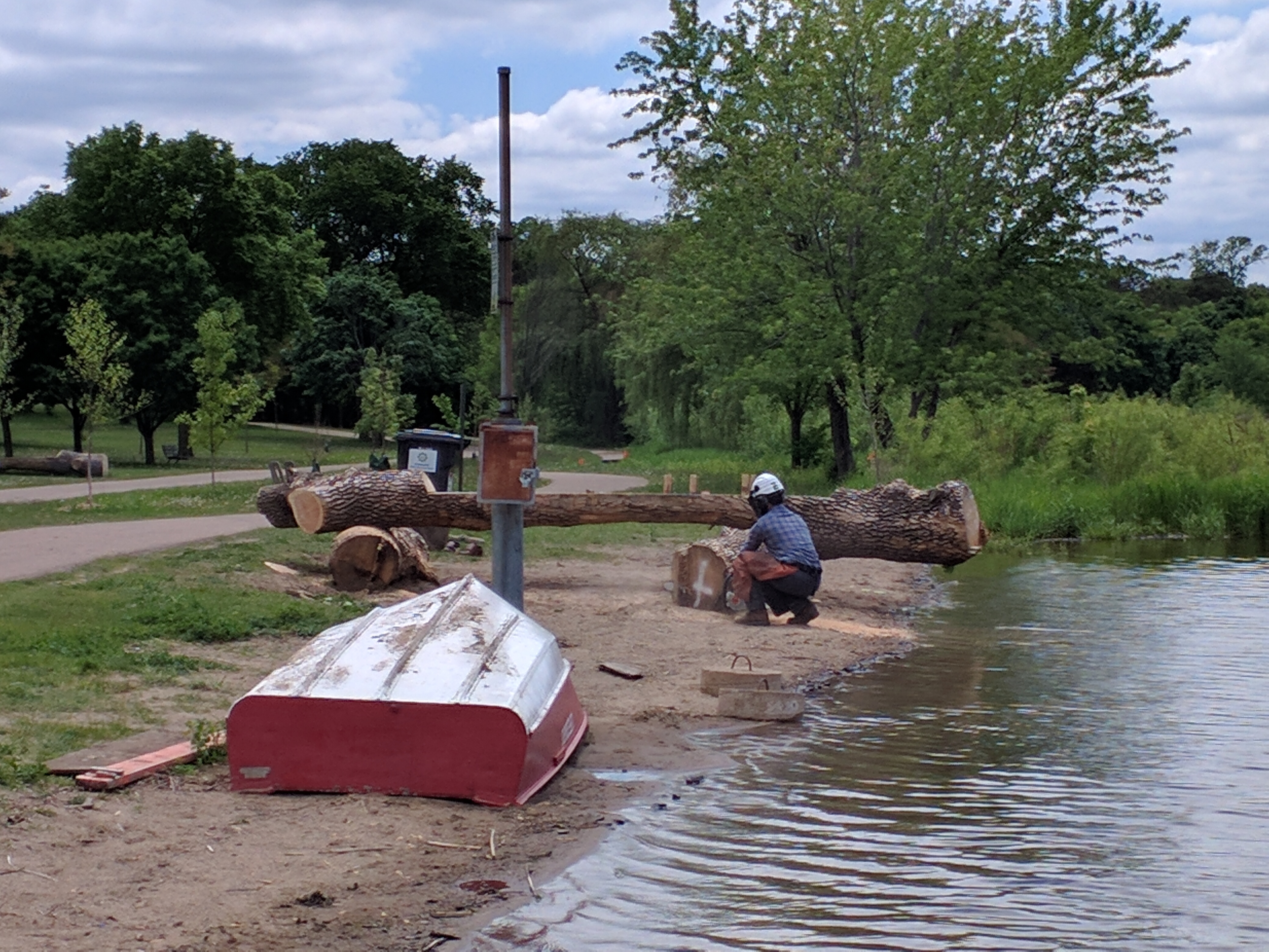I needed a little break after a week of camping in Pierre, so a little time spent among familiar papers in the Twin Cities–those of Saint Paul Mayor George Latimer–seemed just fine by me. Of course, given that the Minnesota Historical Society is closed on Monday, I decided to head up to a collection that had always intrigued me, the papers of Gene Wenstrom, perennial Seventh District congressional candidate in the early 1980s.
Challenging incumbent Independent-Republican Arlan Stangeland, who won the vacated congressional seat of Secretary of Agriculture Bob Bergland in 1977, Wenstrom ran unsuccessfully three times, but lost each time by frustratingly close-yet-far margins. Apparently, though, according to Saint Cloud State University archivist Tom Steman, these papers have not been (or rarely been) accessed. Given the funding issues facing Minnesota system schools, I was lucky to visit SCSU on a day where they were open and able to help me. Tom was incredibly accommodating, and I truly hope they’re eventually able to get a little more of the funding they need to accession and acquire the political papers of still-relevant political figures in northern Minnesota politics.
After a Monday going through Wenstrom’s papers, I turned my attention towards Latimer, who led Saint Paul from 1976 to 1990 and ran an ill-fated campaign against incumbent governor Rudy Perpich in the 1986 Democratic-Farmer-Labor (DFL) primary. As a heads-up, George Latimer is an incredibly important figure in the social and political history of urban Saint Paul. The imposing, friendly, bearded mayor became an icon in both the city and state politics and built the foundations for modern Saint Paul. Unfortunately, my treatment of him here focuses on his engagement with the DFL in statewide elections, not his work for the city. That’s something I assure you I’ve paid attention to, but it’s not addressed here.
The Research
Collections:
Gene Wenstrom Papers (18%)
Central Minnesota Legislators’ Oral Histories (2%)
George Latimer Papers (80%)
Observations:
Setting the stage for Collin: Wenstrom, a teacher-turned-legislator from Elbow Lake, Minnesota, went from representing Minnesota District 11A as a DFLer to challenging Arlan Stangeland for the Minnesota 7th District seat in 1978, 1980, and 1982. Running “on the issues” that Stangeland “ducked a challenge for a debate, voted against disaster aid for farmers and small business, and…continued his steady course of voting for and supporting legislation to aid big oil and the special interests,” Wenstrom’s positions look eerily similar to those of current 7th District Rep. Collin Peterson (DFL), who lost by a smaller margin to Stangeland in 1984 and a recount-worthy margin in 1986 before unseating him in 1980.[1]
Keeping with Peterson’s modern-day criticisms of the Democratic Party for falling out of touch with rural Democrats from traditionally-conservative districts, Wenstrom suffered from a disconnect with Democratic Congressional Campaign Committee chair Tony Coelho (D-CA). He sent a clearly-frustrated letter to Coelho in July 1982, noting that “for three months I have been trying to get your committee to make a contribution to my campaign, each time I’ve been told well perhaps in late July or August and lately now September.”[2] Eventually Wenstrom sent Bruce Vento (DFL-MN4, Saint Paul) to shake down Coelho on the House floor, but the lack of support has become a consistent theme from Minnesota’s Seventh, which has been reliably DFL since 1990.
As Wenstrom and Peterson supporters had clashed ahead of primaries in 1982 over whether it was Gene or Collin’s turn to run against Stangeland, we’re seeing familiarity breed a little contempt between supporters of two rather similar candidates. In a hypothetical world, I’d bet that if Wenstrom ran in 1990 he’d have won. Either way, we see the basis of support for a conservative Democrat from the Minnesota Seventh in Wenstrom and more generally in the oral histories of local legislators that the CMNHS was so kind to help me access.
Rural-Urban-Range politics: As soon as Latimer won yet another election as mayor of Saint Paul in 1985, talk heated up about his potential intention to run for governor in 1986. [Teaser: Don’t believe the “Aw, shucks” image given off by the Latimer campaign. His ambitions as early as the 1984 DNC were to run for governor.] The Saint Paul Pioneer Press‘ John Camp opined that “if Latimer held Perpich victory margin on the Range to only 2-1…,” he “would have to match Spannaus’ strength in Minneapolis and St. Paul” and “devise a farm program with potential to help the agricultural segment of the state.”[3]
That was, however, easier said than done. While Perpich was presumably vulnerable in both the Metro and downstate Minnesota, his campaign made a concentrated effort to run stronger in the Metro in 1986, touting his business record and the state’s improving urban economy. While he was initially hurt by sending the National Guard on striking Hormel meatpackers in the 1985-86 strike, Perpich rebounded and used his business-friendly image to build a coalition that only lost three counties–Ramsey (home to St. Paul), Washington (immediately east), and Dakota (immediately south and my home country)–to Latimer, notably eking past him in Hennepin (home to Minneapolis). Further compounding issues were Latimer’s selection of Minneapolis First Lady Arvonne Fraser (wife of Mayor and 1978 U.S. Senate primary candidate Don) as his running mate. Having been turned down by Duluth mayoral candidate Shirley Swain, who surely would have added Iron Range credibility to Latimer’s candidacy, he settled on Arvonne as a means of exciting progressive turnout in the Twin Cities to offset Perpich’s support on the Range. That…backfired.
It was a coup for the governor supposedly only backed by the northeast Iron Range to run that well across the state, and it both demonstrated Perpich’s surprising ability to build a statewide coalition and destroyed Latimer’s statewide political career. While it was to the eternal benefit of Saint Paul’s racial, political, and business climate (Latimer truly bridged all sections of the capital city, though critics by 1990 contended he was operating as a wannabe urban boss) that Latimer remained mayor, the DFL’s Metro elites’ insistence that Latimer run likely cut short another promising DFLer’s statewide career.
Taking turns in the DFL: This had first played itself out in the 1982 DFL primary (and I’ll address it below), but George Latimer seemed to be the victim of an unfortunate tendency in the DFL hierarchy to dub a political figure–often from the Metro–the heir apparent to the governorship.
In any regard, I couldn’t help but feel a twinge of sympathy for Latimer, followed by intense annoyance at the DFL’s apparent desire to guide the gubernatorial nomination to whoever “deserved” it. Especially in the “Age of Reagan” (to use the historiographic parlance), social conservatives and “budget hawks” alike were given to intense suspicion of the “tax-and-spend liberals” of the urban Metro.
What to make of Rudy?: This leads, almost directly, into the buzzsaw that was Governor Rudy Perpich. The goofy Croatian dentist from the Iron Range confounded partisan loyalties in Minnesota politics for the better part of a decade, returning from work for Control Data Corporation in Vienna to challenge and defeat party-endorsed Warren Spannaus in 1982, then ride roughshod over Latimer in the 1986 DFL primary.
Here’s the thing: No one’s all that confident Perpich was that liberal…but he sure wasn’t conservative, either. The business-friendly governor, who feuded publicly with South Dakota Gov. Bill Janklow and undertook everything from the Mall of America to an Iron Range amusement park and Northwoods cheese factory, was not popular with the elite of either party–but he was popular enough with Minnesotans to cruise to consecutive victories before extending himself too far in running again in 1990.
While I contend–so far–that Perpich is a primary reason DFLers have remained prominent in outstate areas given to the conservative turn in Iowa and Wisconsin, he also stunted the “take turns” approach of Minnesota DFLers, riding past the candidacies of Spannaus, Latimer, and Mike Hatch (all Metro-area candidates, it’s worth noting) and leaving the top of the party ticket vulnerable to a fiscally-conservative but socially-meh Independent-Republican.
Someday we’ll talk about Arne Carlson, Tim Penny, Dean Barkley, and Tom Horner. Someday.
The City
Lodging
Home. Inver Grove Heights. More comfortable than having half a tent blow in on me.
Sightseeing
I’m writing this nearly a month later, and as I have trouble remembering what I had for breakfast, I can assure you that what I did this week while I was staying at home did not stick in my head. Sorry to anyone I’ve wronged.
The Beer
Of course, as I say that, I do remember heading with my fiance Laura to a couple of breweries in Minneapolis for some occasion, though I don’t remember what.
Herkimer: Part of the Lynlake neighborhood just east of Uptown Minneapolis, Herkimer Pub and Brewery is a quality restaurant, bar, brewery, and nightlife spot (immediately adjacent to the best trivia in MSP at the Uptown VFW–go Roaming Herd of Cows). Having finished a long-distance run earlier that morning as part of her prep for Grandma’s Marathon, Laura opted for the lower-ABV Tooler’s Weiss, a solid weissbier, while I opted for a Schwarz. Both were just fine, and we enjoyed a sunny afternoon playing bags on the patio.
Utepils: Located just west of the Minneapolis Farmers’ Market, Utepils was a large but very wonderful detour on a day in which–HANG ON, I REMEMBERED. We went to Lake Hiawatha because emerald ash borers prompted Minneapolis to cut down a bunch of trees and repurpose some. They made a few into cribbage boards, so Laura and I stopped by and played life-size cribbage (I won):

Anyways, Utepils. Big industrial space located over the tracks in Bryn Mawr, pushed right up against a park’s grove of trees to the west of the brewery and tucked away in a way that made it both urban and secluded all at once. I tried the Alt 1848, a sweet, malty altbier, which was just fine, but Laura’s choice–Ewald the Golden, a hefeweizen–was easily the winner in my book. Crisp and citrusy, that’s a summer beer I can get behind.
Bald Man Brewing: Located in an office park along MN-13 in Eagan, Bald Man has a rock-themed lineup of beers ranging from their flagship Tupelo Honey Brown to the Killer Queen IIPA. Their brown has a nice smoky, almost tobacco-y, flavor to it, while the Honey Hush Kolsch had a light sweetness to it. I’m not sure if this is really what I’m supposed to be looking for in a kolsch–after all, the lagering process is supposed to get rid of some of the beer’s sweetness–but it worked for me. Check them out if you’re headed down to the outlets in Eagan or merely want to try a new, interesting suburban brewery.
Saint Cloud? Hopefully next time I’ll take more than a day trip to Saint Cloud and have the chance to check out a local brewery or two. We’ll see what’s emerged up north that’s not Third Street Brewhouse (still an excellent option…Hunny-Do is a great summer beer).
What’s Next?
I followed up Saints Cloud and Paul with a whirlwind swing through Ames, Iowa (1 day); Bloomington, Indiana (2.5 days); Black River Falls, Wisconsin (2.5 days); Iowa City (2 days); Grand Rapids, Michigan (5 days); home (1 day); Iowa City (4 days); Duluth (2.5 days); and Sioux Falls (.5 day). I’ll be blogging about Iowa City, then Bloomington and Grand Rapids (conferences, both), then Duluth and Sioux Falls. I think. We’ll see.
Past Trips
[1] “Wenstrom Newsletter, Vol. 2,” Box 1, Folder 6 (2), Gene Wenstrom Papers. Central Minnesota Historical Collection, St. Cloud State University Archives, St. Cloud, Minnesota; election results accessed by year at “Minnesota Elections: Dates and Vote Totals,” Minnesota Legislative Reference Library, https://www.leg.state.mn.us/lrl/mngov/electionresults. [2] Wenstrom to Coelho, July 8, 1982, Box 3, Folder 4, Wenstrom Papers. [3] John Camp, “Latimer’s chances add up,” Saint Paul Pioneer Press, January 30, 1986.

